Leadership Analysis of Sardar Vallabhbhai Patel: A Report
VerifiedAdded on 2019/10/30
|14
|2892
|1657
Report
AI Summary
This report provides a strategic leadership analysis of Sardar Vallabhbhai Patel, focusing on his notable works, achievements, and leadership skills. It examines his role in the integration of Indian princely states, highlighting his decision-making abilities, influence, and adaptability. The report delves into his transformational leadership style, discussing his strengths such as determination and conflict resolution, as well as potential weaknesses. It covers his contributions to the formation of modern India, including his establishment of key institutions and his influence on economic and political development. The analysis draws on historical context and scholarly sources to understand the impact of his leadership and his legacy as the 'Iron Man of India'.

Paraphrase This Document
Need a fresh take? Get an instant paraphrase of this document with our AI Paraphraser
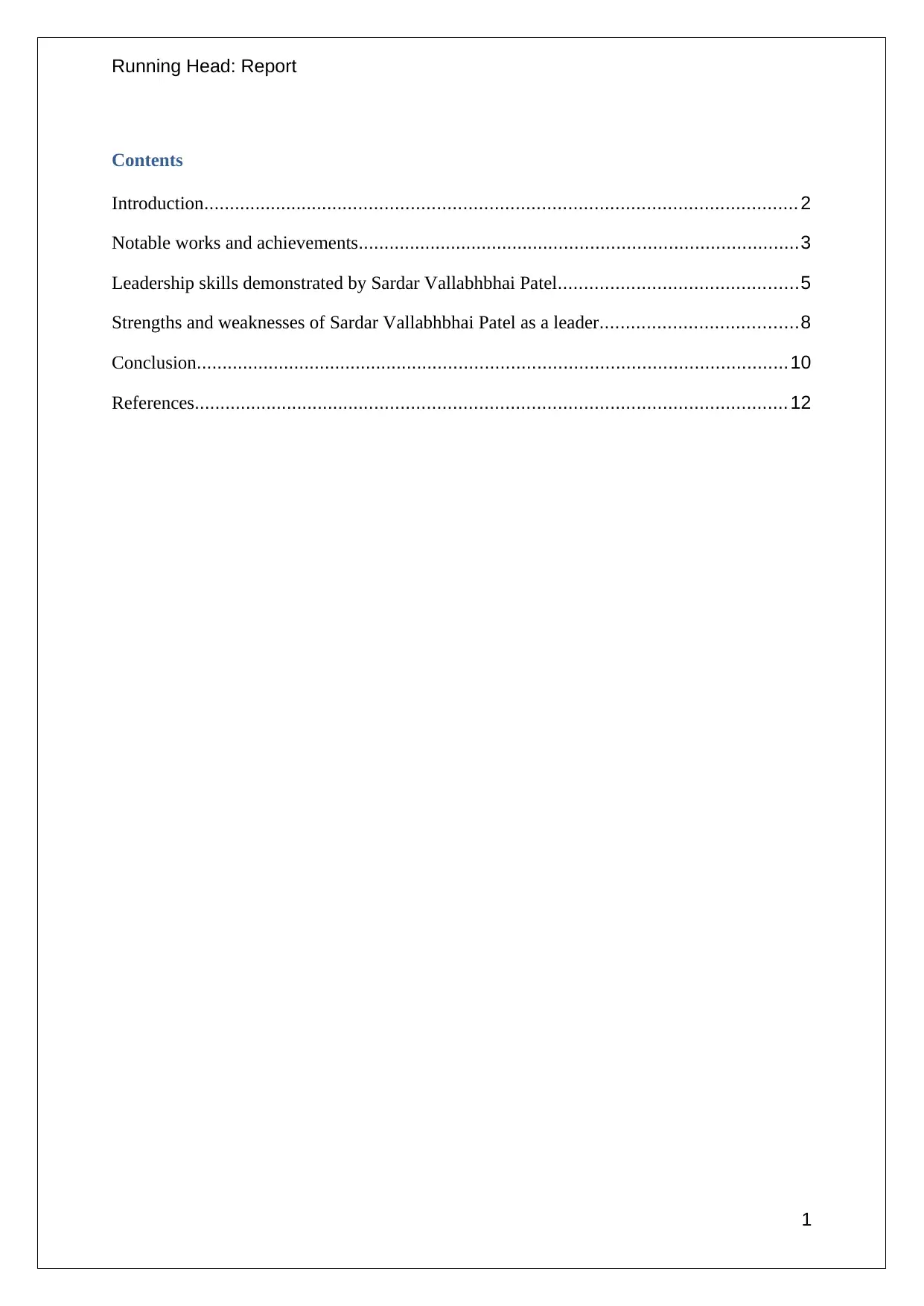
Running Head: Report
Contents
Introduction.................................................................................................................. 2
Notable works and achievements.....................................................................................3
Leadership skills demonstrated by Sardar Vallabhbhai Patel..............................................5
Strengths and weaknesses of Sardar Vallabhbhai Patel as a leader......................................8
Conclusion..................................................................................................................10
References.................................................................................................................. 12
1
Contents
Introduction.................................................................................................................. 2
Notable works and achievements.....................................................................................3
Leadership skills demonstrated by Sardar Vallabhbhai Patel..............................................5
Strengths and weaknesses of Sardar Vallabhbhai Patel as a leader......................................8
Conclusion..................................................................................................................10
References.................................................................................................................. 12
1
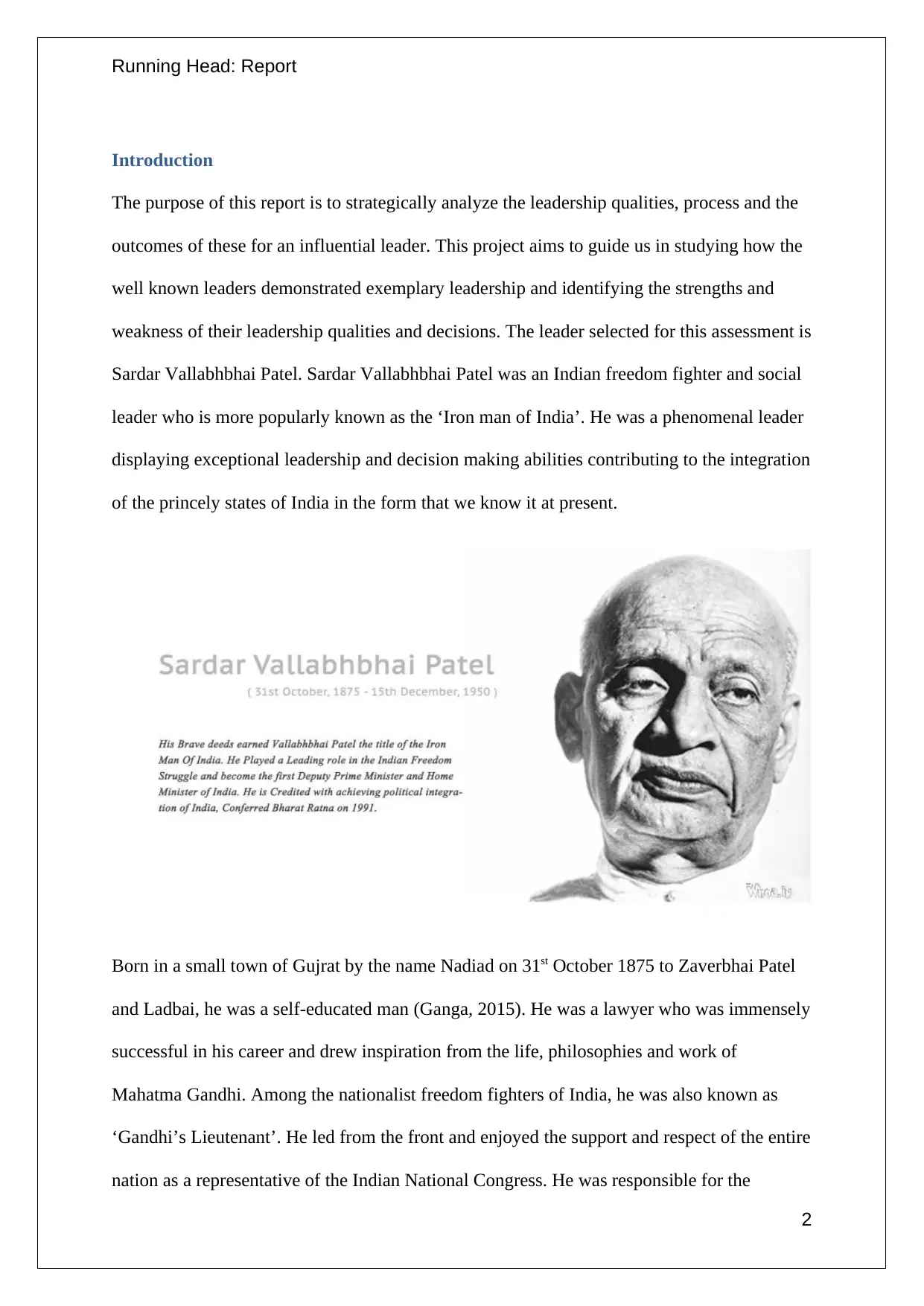
Running Head: Report
Introduction
The purpose of this report is to strategically analyze the leadership qualities, process and the
outcomes of these for an influential leader. This project aims to guide us in studying how the
well known leaders demonstrated exemplary leadership and identifying the strengths and
weakness of their leadership qualities and decisions. The leader selected for this assessment is
Sardar Vallabhbhai Patel. Sardar Vallabhbhai Patel was an Indian freedom fighter and social
leader who is more popularly known as the ‘Iron man of India’. He was a phenomenal leader
displaying exceptional leadership and decision making abilities contributing to the integration
of the princely states of India in the form that we know it at present.
Born in a small town of Gujrat by the name Nadiad on 31st October 1875 to Zaverbhai Patel
and Ladbai, he was a self-educated man (Ganga, 2015). He was a lawyer who was immensely
successful in his career and drew inspiration from the life, philosophies and work of
Mahatma Gandhi. Among the nationalist freedom fighters of India, he was also known as
‘Gandhi’s Lieutenant’. He led from the front and enjoyed the support and respect of the entire
nation as a representative of the Indian National Congress. He was responsible for the
2
Introduction
The purpose of this report is to strategically analyze the leadership qualities, process and the
outcomes of these for an influential leader. This project aims to guide us in studying how the
well known leaders demonstrated exemplary leadership and identifying the strengths and
weakness of their leadership qualities and decisions. The leader selected for this assessment is
Sardar Vallabhbhai Patel. Sardar Vallabhbhai Patel was an Indian freedom fighter and social
leader who is more popularly known as the ‘Iron man of India’. He was a phenomenal leader
displaying exceptional leadership and decision making abilities contributing to the integration
of the princely states of India in the form that we know it at present.
Born in a small town of Gujrat by the name Nadiad on 31st October 1875 to Zaverbhai Patel
and Ladbai, he was a self-educated man (Ganga, 2015). He was a lawyer who was immensely
successful in his career and drew inspiration from the life, philosophies and work of
Mahatma Gandhi. Among the nationalist freedom fighters of India, he was also known as
‘Gandhi’s Lieutenant’. He led from the front and enjoyed the support and respect of the entire
nation as a representative of the Indian National Congress. He was responsible for the
2
⊘ This is a preview!⊘
Do you want full access?
Subscribe today to unlock all pages.

Trusted by 1+ million students worldwide
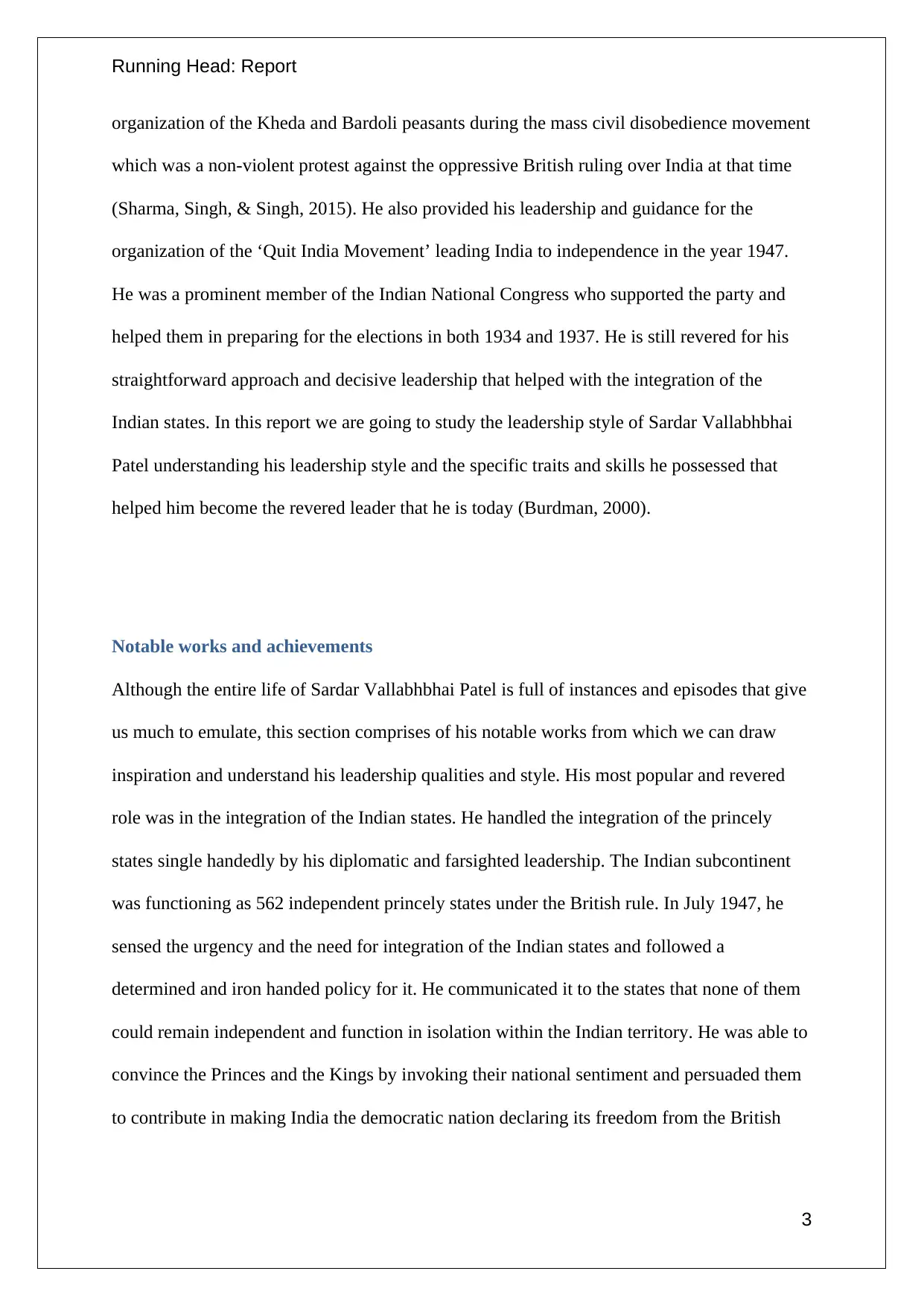
Running Head: Report
organization of the Kheda and Bardoli peasants during the mass civil disobedience movement
which was a non-violent protest against the oppressive British ruling over India at that time
(Sharma, Singh, & Singh, 2015). He also provided his leadership and guidance for the
organization of the ‘Quit India Movement’ leading India to independence in the year 1947.
He was a prominent member of the Indian National Congress who supported the party and
helped them in preparing for the elections in both 1934 and 1937. He is still revered for his
straightforward approach and decisive leadership that helped with the integration of the
Indian states. In this report we are going to study the leadership style of Sardar Vallabhbhai
Patel understanding his leadership style and the specific traits and skills he possessed that
helped him become the revered leader that he is today (Burdman, 2000).
Notable works and achievements
Although the entire life of Sardar Vallabhbhai Patel is full of instances and episodes that give
us much to emulate, this section comprises of his notable works from which we can draw
inspiration and understand his leadership qualities and style. His most popular and revered
role was in the integration of the Indian states. He handled the integration of the princely
states single handedly by his diplomatic and farsighted leadership. The Indian subcontinent
was functioning as 562 independent princely states under the British rule. In July 1947, he
sensed the urgency and the need for integration of the Indian states and followed a
determined and iron handed policy for it. He communicated it to the states that none of them
could remain independent and function in isolation within the Indian territory. He was able to
convince the Princes and the Kings by invoking their national sentiment and persuaded them
to contribute in making India the democratic nation declaring its freedom from the British
3
organization of the Kheda and Bardoli peasants during the mass civil disobedience movement
which was a non-violent protest against the oppressive British ruling over India at that time
(Sharma, Singh, & Singh, 2015). He also provided his leadership and guidance for the
organization of the ‘Quit India Movement’ leading India to independence in the year 1947.
He was a prominent member of the Indian National Congress who supported the party and
helped them in preparing for the elections in both 1934 and 1937. He is still revered for his
straightforward approach and decisive leadership that helped with the integration of the
Indian states. In this report we are going to study the leadership style of Sardar Vallabhbhai
Patel understanding his leadership style and the specific traits and skills he possessed that
helped him become the revered leader that he is today (Burdman, 2000).
Notable works and achievements
Although the entire life of Sardar Vallabhbhai Patel is full of instances and episodes that give
us much to emulate, this section comprises of his notable works from which we can draw
inspiration and understand his leadership qualities and style. His most popular and revered
role was in the integration of the Indian states. He handled the integration of the princely
states single handedly by his diplomatic and farsighted leadership. The Indian subcontinent
was functioning as 562 independent princely states under the British rule. In July 1947, he
sensed the urgency and the need for integration of the Indian states and followed a
determined and iron handed policy for it. He communicated it to the states that none of them
could remain independent and function in isolation within the Indian territory. He was able to
convince the Princes and the Kings by invoking their national sentiment and persuaded them
to contribute in making India the democratic nation declaring its freedom from the British
3
Paraphrase This Document
Need a fresh take? Get an instant paraphrase of this document with our AI Paraphraser
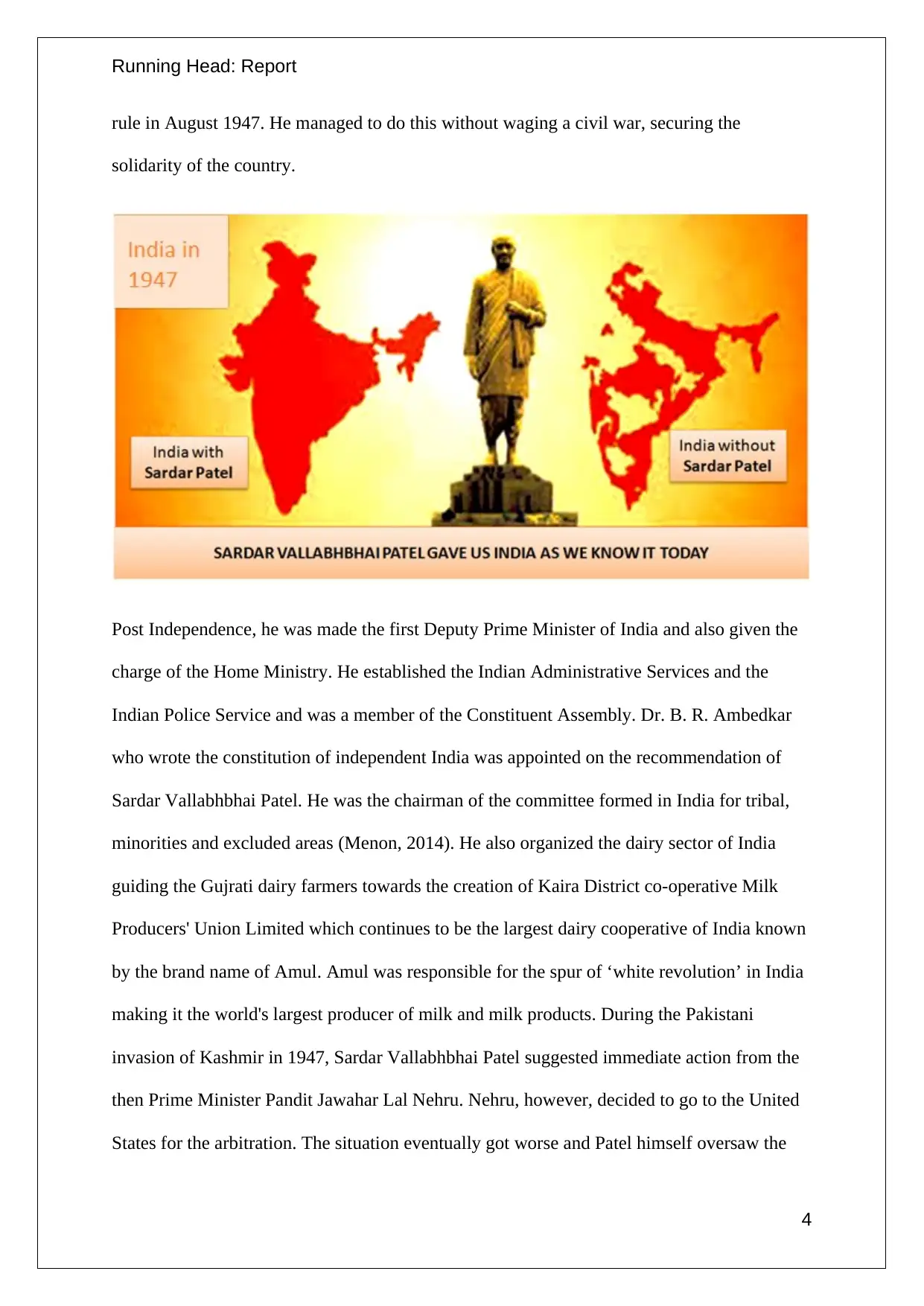
Running Head: Report
rule in August 1947. He managed to do this without waging a civil war, securing the
solidarity of the country.
Post Independence, he was made the first Deputy Prime Minister of India and also given the
charge of the Home Ministry. He established the Indian Administrative Services and the
Indian Police Service and was a member of the Constituent Assembly. Dr. B. R. Ambedkar
who wrote the constitution of independent India was appointed on the recommendation of
Sardar Vallabhbhai Patel. He was the chairman of the committee formed in India for tribal,
minorities and excluded areas (Menon, 2014). He also organized the dairy sector of India
guiding the Gujrati dairy farmers towards the creation of Kaira District co-operative Milk
Producers' Union Limited which continues to be the largest dairy cooperative of India known
by the brand name of Amul. Amul was responsible for the spur of ‘white revolution’ in India
making it the world's largest producer of milk and milk products. During the Pakistani
invasion of Kashmir in 1947, Sardar Vallabhbhai Patel suggested immediate action from the
then Prime Minister Pandit Jawahar Lal Nehru. Nehru, however, decided to go to the United
States for the arbitration. The situation eventually got worse and Patel himself oversaw the
4
rule in August 1947. He managed to do this without waging a civil war, securing the
solidarity of the country.
Post Independence, he was made the first Deputy Prime Minister of India and also given the
charge of the Home Ministry. He established the Indian Administrative Services and the
Indian Police Service and was a member of the Constituent Assembly. Dr. B. R. Ambedkar
who wrote the constitution of independent India was appointed on the recommendation of
Sardar Vallabhbhai Patel. He was the chairman of the committee formed in India for tribal,
minorities and excluded areas (Menon, 2014). He also organized the dairy sector of India
guiding the Gujrati dairy farmers towards the creation of Kaira District co-operative Milk
Producers' Union Limited which continues to be the largest dairy cooperative of India known
by the brand name of Amul. Amul was responsible for the spur of ‘white revolution’ in India
making it the world's largest producer of milk and milk products. During the Pakistani
invasion of Kashmir in 1947, Sardar Vallabhbhai Patel suggested immediate action from the
then Prime Minister Pandit Jawahar Lal Nehru. Nehru, however, decided to go to the United
States for the arbitration. The situation eventually got worse and Patel himself oversaw the
4
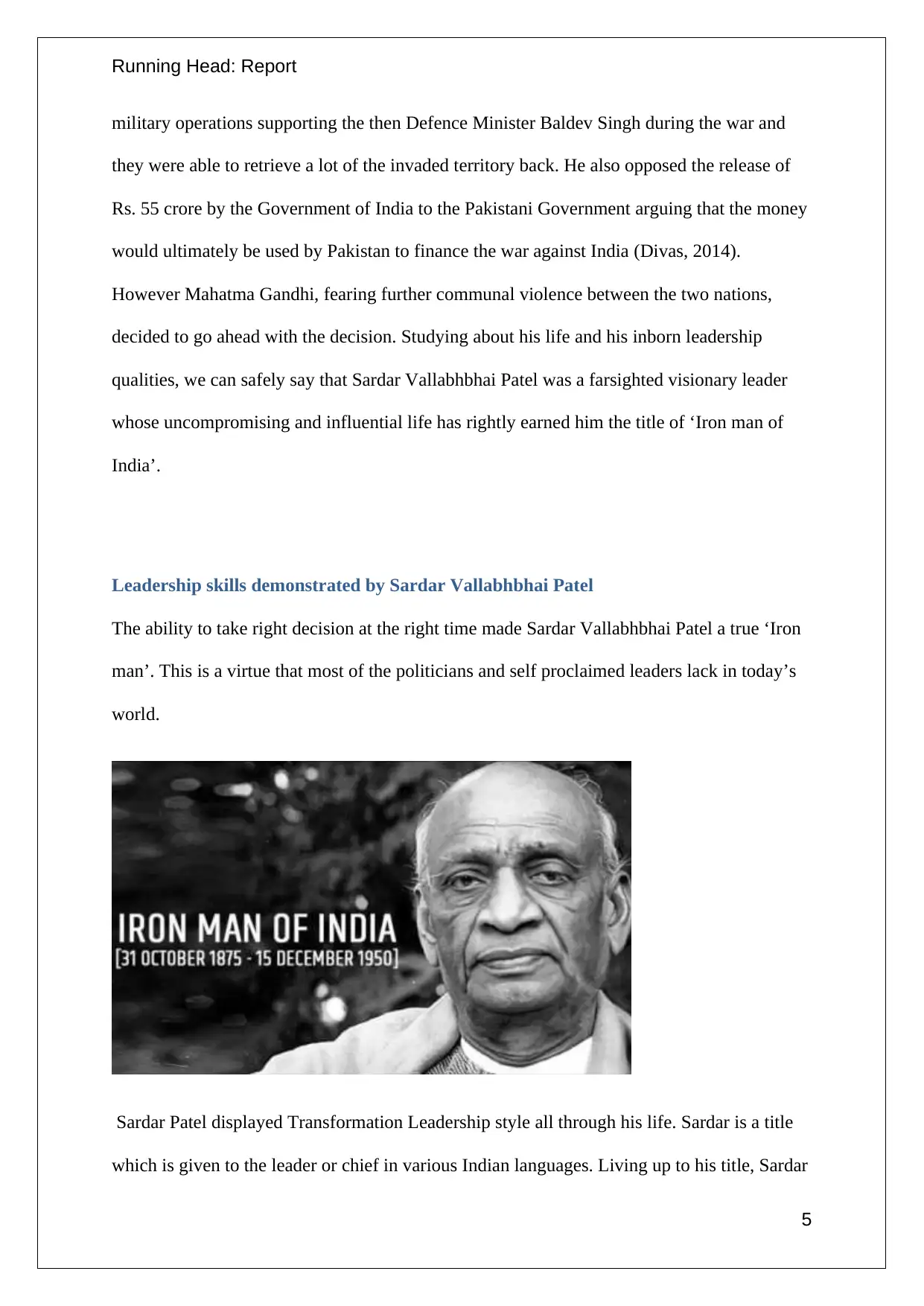
Running Head: Report
military operations supporting the then Defence Minister Baldev Singh during the war and
they were able to retrieve a lot of the invaded territory back. He also opposed the release of
Rs. 55 crore by the Government of India to the Pakistani Government arguing that the money
would ultimately be used by Pakistan to finance the war against India (Divas, 2014).
However Mahatma Gandhi, fearing further communal violence between the two nations,
decided to go ahead with the decision. Studying about his life and his inborn leadership
qualities, we can safely say that Sardar Vallabhbhai Patel was a farsighted visionary leader
whose uncompromising and influential life has rightly earned him the title of ‘Iron man of
India’.
Leadership skills demonstrated by Sardar Vallabhbhai Patel
The ability to take right decision at the right time made Sardar Vallabhbhai Patel a true ‘Iron
man’. This is a virtue that most of the politicians and self proclaimed leaders lack in today’s
world.
Sardar Patel displayed Transformation Leadership style all through his life. Sardar is a title
which is given to the leader or chief in various Indian languages. Living up to his title, Sardar
5
military operations supporting the then Defence Minister Baldev Singh during the war and
they were able to retrieve a lot of the invaded territory back. He also opposed the release of
Rs. 55 crore by the Government of India to the Pakistani Government arguing that the money
would ultimately be used by Pakistan to finance the war against India (Divas, 2014).
However Mahatma Gandhi, fearing further communal violence between the two nations,
decided to go ahead with the decision. Studying about his life and his inborn leadership
qualities, we can safely say that Sardar Vallabhbhai Patel was a farsighted visionary leader
whose uncompromising and influential life has rightly earned him the title of ‘Iron man of
India’.
Leadership skills demonstrated by Sardar Vallabhbhai Patel
The ability to take right decision at the right time made Sardar Vallabhbhai Patel a true ‘Iron
man’. This is a virtue that most of the politicians and self proclaimed leaders lack in today’s
world.
Sardar Patel displayed Transformation Leadership style all through his life. Sardar is a title
which is given to the leader or chief in various Indian languages. Living up to his title, Sardar
5
⊘ This is a preview!⊘
Do you want full access?
Subscribe today to unlock all pages.

Trusted by 1+ million students worldwide
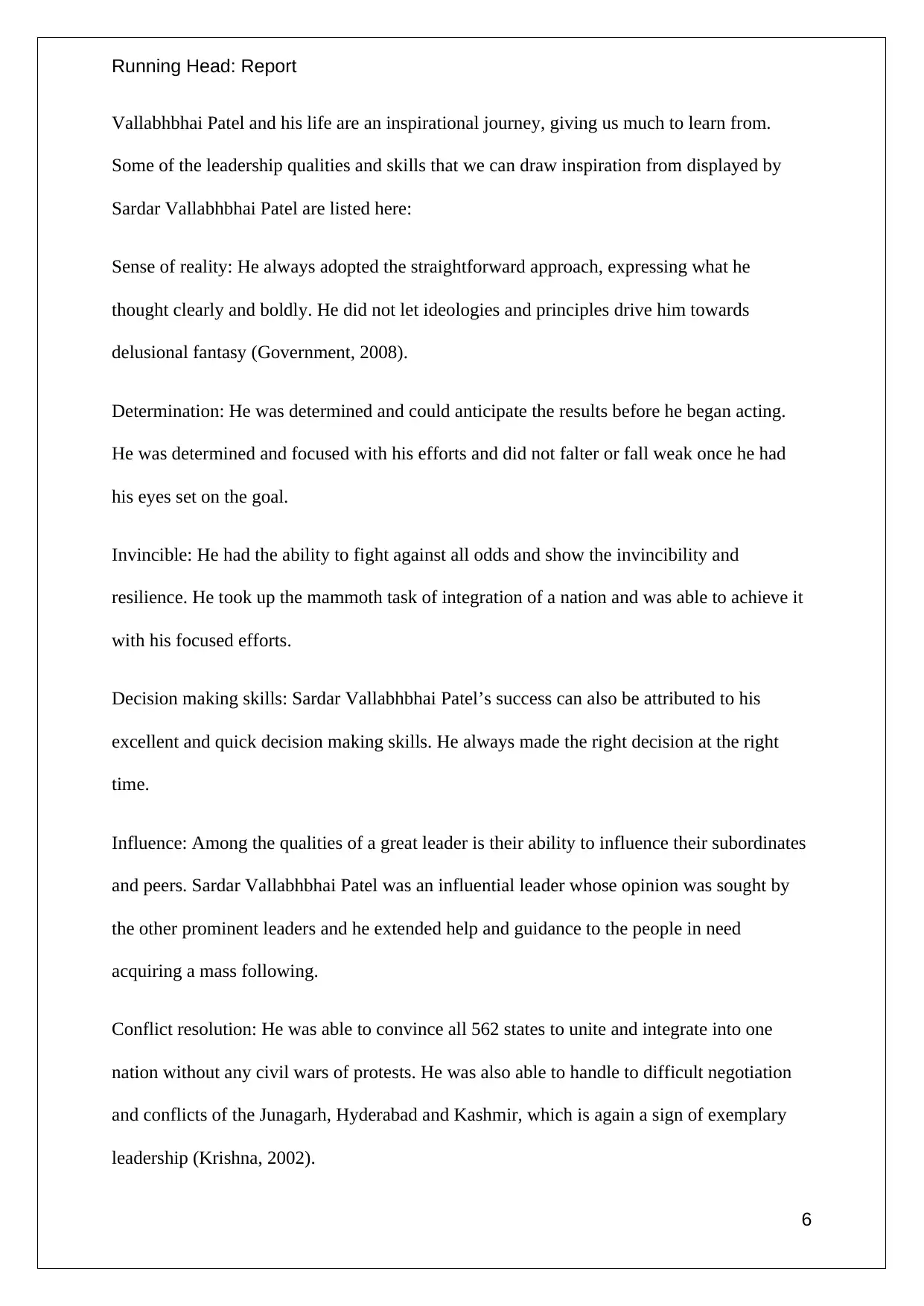
Running Head: Report
Vallabhbhai Patel and his life are an inspirational journey, giving us much to learn from.
Some of the leadership qualities and skills that we can draw inspiration from displayed by
Sardar Vallabhbhai Patel are listed here:
Sense of reality: He always adopted the straightforward approach, expressing what he
thought clearly and boldly. He did not let ideologies and principles drive him towards
delusional fantasy (Government, 2008).
Determination: He was determined and could anticipate the results before he began acting.
He was determined and focused with his efforts and did not falter or fall weak once he had
his eyes set on the goal.
Invincible: He had the ability to fight against all odds and show the invincibility and
resilience. He took up the mammoth task of integration of a nation and was able to achieve it
with his focused efforts.
Decision making skills: Sardar Vallabhbhai Patel’s success can also be attributed to his
excellent and quick decision making skills. He always made the right decision at the right
time.
Influence: Among the qualities of a great leader is their ability to influence their subordinates
and peers. Sardar Vallabhbhai Patel was an influential leader whose opinion was sought by
the other prominent leaders and he extended help and guidance to the people in need
acquiring a mass following.
Conflict resolution: He was able to convince all 562 states to unite and integrate into one
nation without any civil wars of protests. He was also able to handle to difficult negotiation
and conflicts of the Junagarh, Hyderabad and Kashmir, which is again a sign of exemplary
leadership (Krishna, 2002).
6
Vallabhbhai Patel and his life are an inspirational journey, giving us much to learn from.
Some of the leadership qualities and skills that we can draw inspiration from displayed by
Sardar Vallabhbhai Patel are listed here:
Sense of reality: He always adopted the straightforward approach, expressing what he
thought clearly and boldly. He did not let ideologies and principles drive him towards
delusional fantasy (Government, 2008).
Determination: He was determined and could anticipate the results before he began acting.
He was determined and focused with his efforts and did not falter or fall weak once he had
his eyes set on the goal.
Invincible: He had the ability to fight against all odds and show the invincibility and
resilience. He took up the mammoth task of integration of a nation and was able to achieve it
with his focused efforts.
Decision making skills: Sardar Vallabhbhai Patel’s success can also be attributed to his
excellent and quick decision making skills. He always made the right decision at the right
time.
Influence: Among the qualities of a great leader is their ability to influence their subordinates
and peers. Sardar Vallabhbhai Patel was an influential leader whose opinion was sought by
the other prominent leaders and he extended help and guidance to the people in need
acquiring a mass following.
Conflict resolution: He was able to convince all 562 states to unite and integrate into one
nation without any civil wars of protests. He was also able to handle to difficult negotiation
and conflicts of the Junagarh, Hyderabad and Kashmir, which is again a sign of exemplary
leadership (Krishna, 2002).
6
Paraphrase This Document
Need a fresh take? Get an instant paraphrase of this document with our AI Paraphraser
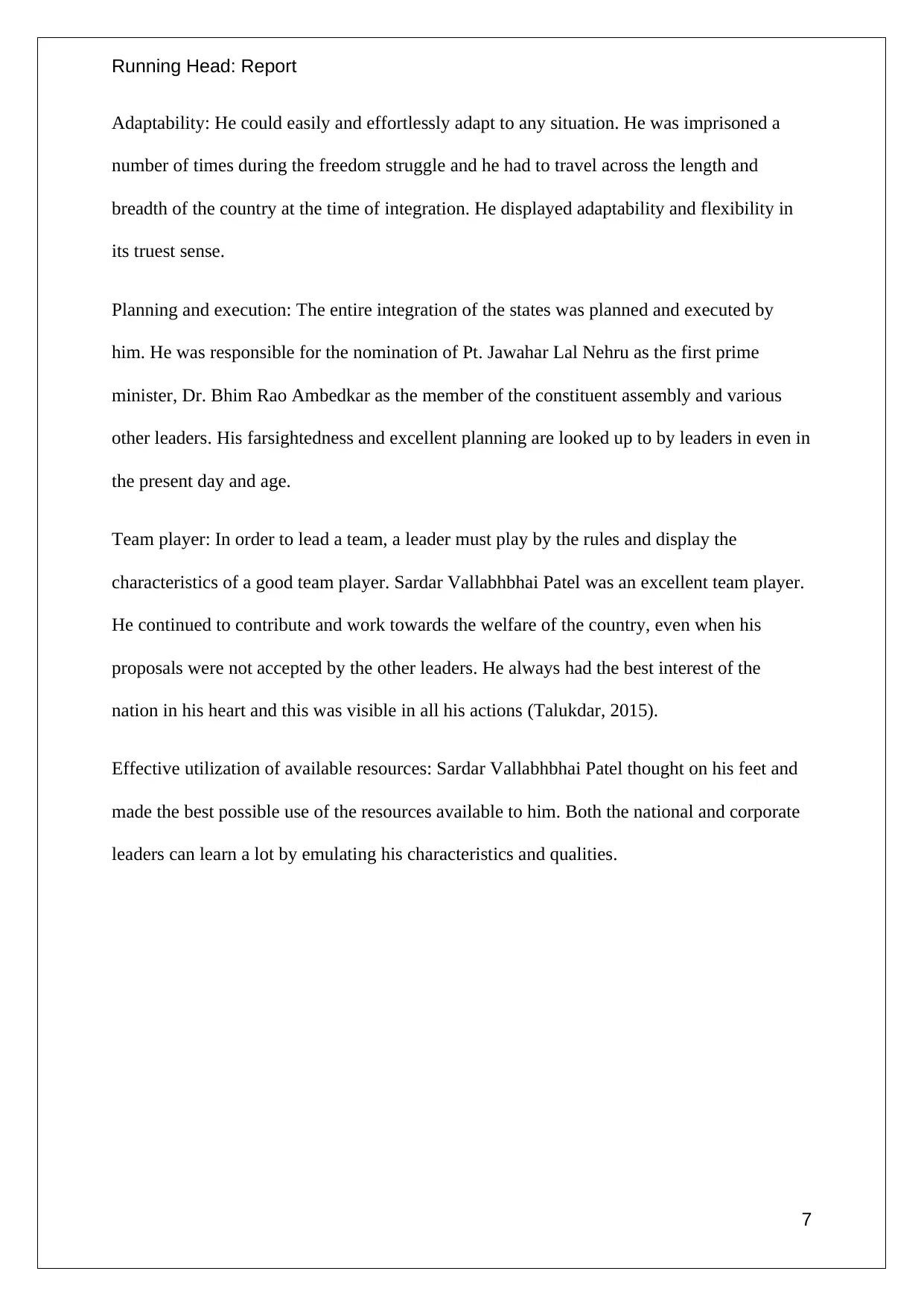
Running Head: Report
Adaptability: He could easily and effortlessly adapt to any situation. He was imprisoned a
number of times during the freedom struggle and he had to travel across the length and
breadth of the country at the time of integration. He displayed adaptability and flexibility in
its truest sense.
Planning and execution: The entire integration of the states was planned and executed by
him. He was responsible for the nomination of Pt. Jawahar Lal Nehru as the first prime
minister, Dr. Bhim Rao Ambedkar as the member of the constituent assembly and various
other leaders. His farsightedness and excellent planning are looked up to by leaders in even in
the present day and age.
Team player: In order to lead a team, a leader must play by the rules and display the
characteristics of a good team player. Sardar Vallabhbhai Patel was an excellent team player.
He continued to contribute and work towards the welfare of the country, even when his
proposals were not accepted by the other leaders. He always had the best interest of the
nation in his heart and this was visible in all his actions (Talukdar, 2015).
Effective utilization of available resources: Sardar Vallabhbhai Patel thought on his feet and
made the best possible use of the resources available to him. Both the national and corporate
leaders can learn a lot by emulating his characteristics and qualities.
7
Adaptability: He could easily and effortlessly adapt to any situation. He was imprisoned a
number of times during the freedom struggle and he had to travel across the length and
breadth of the country at the time of integration. He displayed adaptability and flexibility in
its truest sense.
Planning and execution: The entire integration of the states was planned and executed by
him. He was responsible for the nomination of Pt. Jawahar Lal Nehru as the first prime
minister, Dr. Bhim Rao Ambedkar as the member of the constituent assembly and various
other leaders. His farsightedness and excellent planning are looked up to by leaders in even in
the present day and age.
Team player: In order to lead a team, a leader must play by the rules and display the
characteristics of a good team player. Sardar Vallabhbhai Patel was an excellent team player.
He continued to contribute and work towards the welfare of the country, even when his
proposals were not accepted by the other leaders. He always had the best interest of the
nation in his heart and this was visible in all his actions (Talukdar, 2015).
Effective utilization of available resources: Sardar Vallabhbhai Patel thought on his feet and
made the best possible use of the resources available to him. Both the national and corporate
leaders can learn a lot by emulating his characteristics and qualities.
7
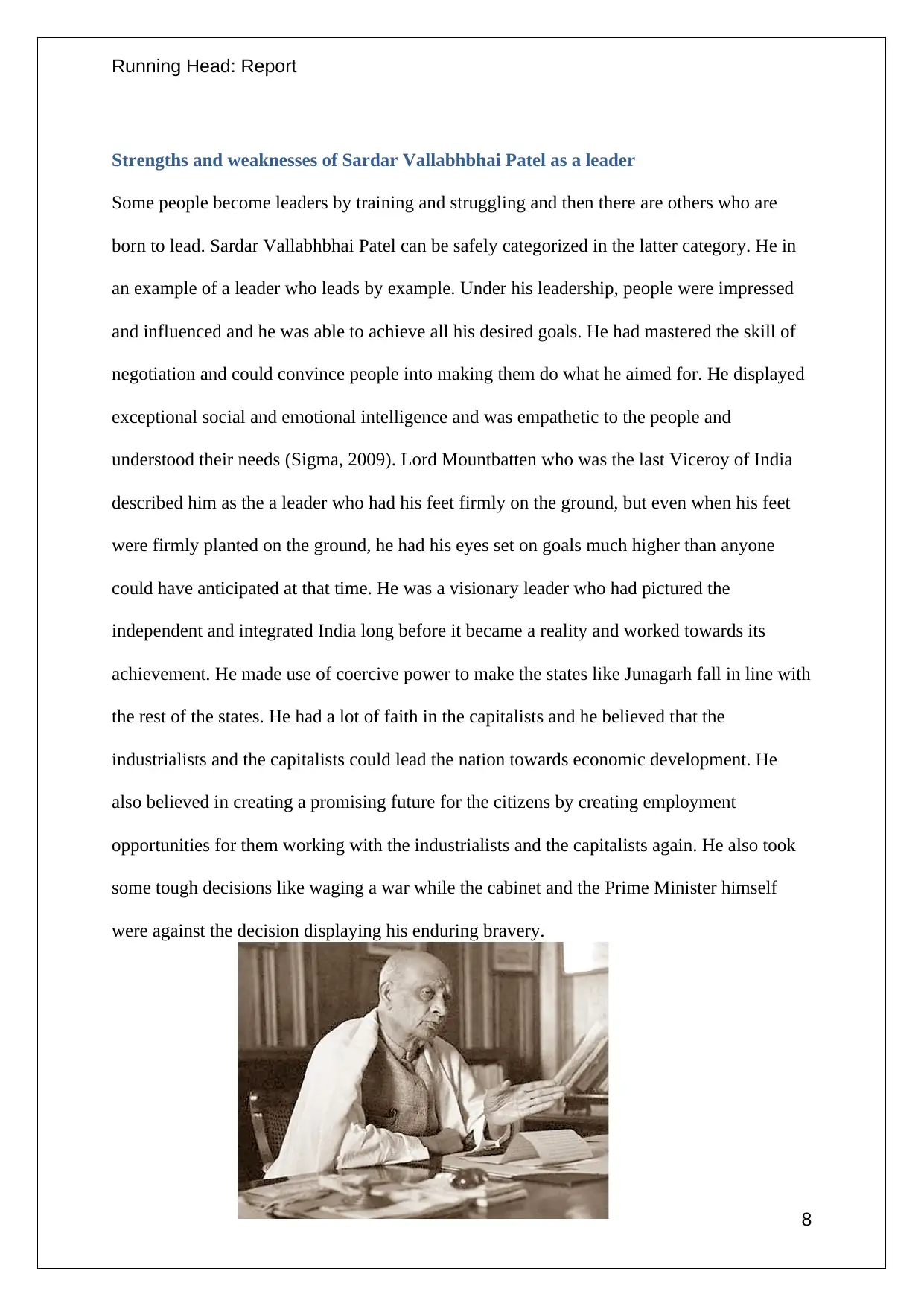
Running Head: Report
Strengths and weaknesses of Sardar Vallabhbhai Patel as a leader
Some people become leaders by training and struggling and then there are others who are
born to lead. Sardar Vallabhbhai Patel can be safely categorized in the latter category. He in
an example of a leader who leads by example. Under his leadership, people were impressed
and influenced and he was able to achieve all his desired goals. He had mastered the skill of
negotiation and could convince people into making them do what he aimed for. He displayed
exceptional social and emotional intelligence and was empathetic to the people and
understood their needs (Sigma, 2009). Lord Mountbatten who was the last Viceroy of India
described him as the a leader who had his feet firmly on the ground, but even when his feet
were firmly planted on the ground, he had his eyes set on goals much higher than anyone
could have anticipated at that time. He was a visionary leader who had pictured the
independent and integrated India long before it became a reality and worked towards its
achievement. He made use of coercive power to make the states like Junagarh fall in line with
the rest of the states. He had a lot of faith in the capitalists and he believed that the
industrialists and the capitalists could lead the nation towards economic development. He
also believed in creating a promising future for the citizens by creating employment
opportunities for them working with the industrialists and the capitalists again. He also took
some tough decisions like waging a war while the cabinet and the Prime Minister himself
were against the decision displaying his enduring bravery.
8
Strengths and weaknesses of Sardar Vallabhbhai Patel as a leader
Some people become leaders by training and struggling and then there are others who are
born to lead. Sardar Vallabhbhai Patel can be safely categorized in the latter category. He in
an example of a leader who leads by example. Under his leadership, people were impressed
and influenced and he was able to achieve all his desired goals. He had mastered the skill of
negotiation and could convince people into making them do what he aimed for. He displayed
exceptional social and emotional intelligence and was empathetic to the people and
understood their needs (Sigma, 2009). Lord Mountbatten who was the last Viceroy of India
described him as the a leader who had his feet firmly on the ground, but even when his feet
were firmly planted on the ground, he had his eyes set on goals much higher than anyone
could have anticipated at that time. He was a visionary leader who had pictured the
independent and integrated India long before it became a reality and worked towards its
achievement. He made use of coercive power to make the states like Junagarh fall in line with
the rest of the states. He had a lot of faith in the capitalists and he believed that the
industrialists and the capitalists could lead the nation towards economic development. He
also believed in creating a promising future for the citizens by creating employment
opportunities for them working with the industrialists and the capitalists again. He also took
some tough decisions like waging a war while the cabinet and the Prime Minister himself
were against the decision displaying his enduring bravery.
8
⊘ This is a preview!⊘
Do you want full access?
Subscribe today to unlock all pages.

Trusted by 1+ million students worldwide
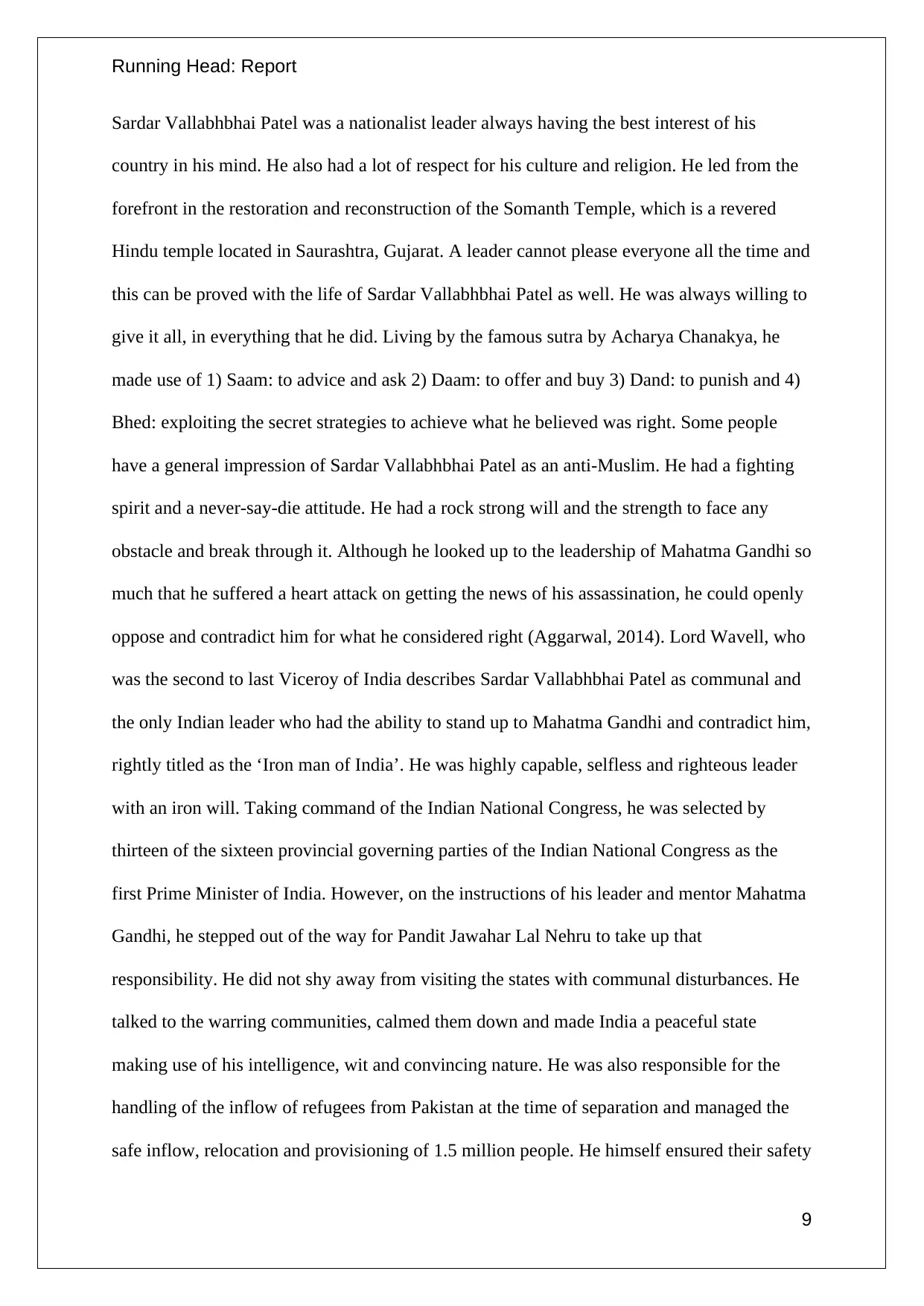
Running Head: Report
Sardar Vallabhbhai Patel was a nationalist leader always having the best interest of his
country in his mind. He also had a lot of respect for his culture and religion. He led from the
forefront in the restoration and reconstruction of the Somanth Temple, which is a revered
Hindu temple located in Saurashtra, Gujarat. A leader cannot please everyone all the time and
this can be proved with the life of Sardar Vallabhbhai Patel as well. He was always willing to
give it all, in everything that he did. Living by the famous sutra by Acharya Chanakya, he
made use of 1) Saam: to advice and ask 2) Daam: to offer and buy 3) Dand: to punish and 4)
Bhed: exploiting the secret strategies to achieve what he believed was right. Some people
have a general impression of Sardar Vallabhbhai Patel as an anti-Muslim. He had a fighting
spirit and a never-say-die attitude. He had a rock strong will and the strength to face any
obstacle and break through it. Although he looked up to the leadership of Mahatma Gandhi so
much that he suffered a heart attack on getting the news of his assassination, he could openly
oppose and contradict him for what he considered right (Aggarwal, 2014). Lord Wavell, who
was the second to last Viceroy of India describes Sardar Vallabhbhai Patel as communal and
the only Indian leader who had the ability to stand up to Mahatma Gandhi and contradict him,
rightly titled as the ‘Iron man of India’. He was highly capable, selfless and righteous leader
with an iron will. Taking command of the Indian National Congress, he was selected by
thirteen of the sixteen provincial governing parties of the Indian National Congress as the
first Prime Minister of India. However, on the instructions of his leader and mentor Mahatma
Gandhi, he stepped out of the way for Pandit Jawahar Lal Nehru to take up that
responsibility. He did not shy away from visiting the states with communal disturbances. He
talked to the warring communities, calmed them down and made India a peaceful state
making use of his intelligence, wit and convincing nature. He was also responsible for the
handling of the inflow of refugees from Pakistan at the time of separation and managed the
safe inflow, relocation and provisioning of 1.5 million people. He himself ensured their safety
9
Sardar Vallabhbhai Patel was a nationalist leader always having the best interest of his
country in his mind. He also had a lot of respect for his culture and religion. He led from the
forefront in the restoration and reconstruction of the Somanth Temple, which is a revered
Hindu temple located in Saurashtra, Gujarat. A leader cannot please everyone all the time and
this can be proved with the life of Sardar Vallabhbhai Patel as well. He was always willing to
give it all, in everything that he did. Living by the famous sutra by Acharya Chanakya, he
made use of 1) Saam: to advice and ask 2) Daam: to offer and buy 3) Dand: to punish and 4)
Bhed: exploiting the secret strategies to achieve what he believed was right. Some people
have a general impression of Sardar Vallabhbhai Patel as an anti-Muslim. He had a fighting
spirit and a never-say-die attitude. He had a rock strong will and the strength to face any
obstacle and break through it. Although he looked up to the leadership of Mahatma Gandhi so
much that he suffered a heart attack on getting the news of his assassination, he could openly
oppose and contradict him for what he considered right (Aggarwal, 2014). Lord Wavell, who
was the second to last Viceroy of India describes Sardar Vallabhbhai Patel as communal and
the only Indian leader who had the ability to stand up to Mahatma Gandhi and contradict him,
rightly titled as the ‘Iron man of India’. He was highly capable, selfless and righteous leader
with an iron will. Taking command of the Indian National Congress, he was selected by
thirteen of the sixteen provincial governing parties of the Indian National Congress as the
first Prime Minister of India. However, on the instructions of his leader and mentor Mahatma
Gandhi, he stepped out of the way for Pandit Jawahar Lal Nehru to take up that
responsibility. He did not shy away from visiting the states with communal disturbances. He
talked to the warring communities, calmed them down and made India a peaceful state
making use of his intelligence, wit and convincing nature. He was also responsible for the
handling of the inflow of refugees from Pakistan at the time of separation and managed the
safe inflow, relocation and provisioning of 1.5 million people. He himself ensured their safety
9
Paraphrase This Document
Need a fresh take? Get an instant paraphrase of this document with our AI Paraphraser
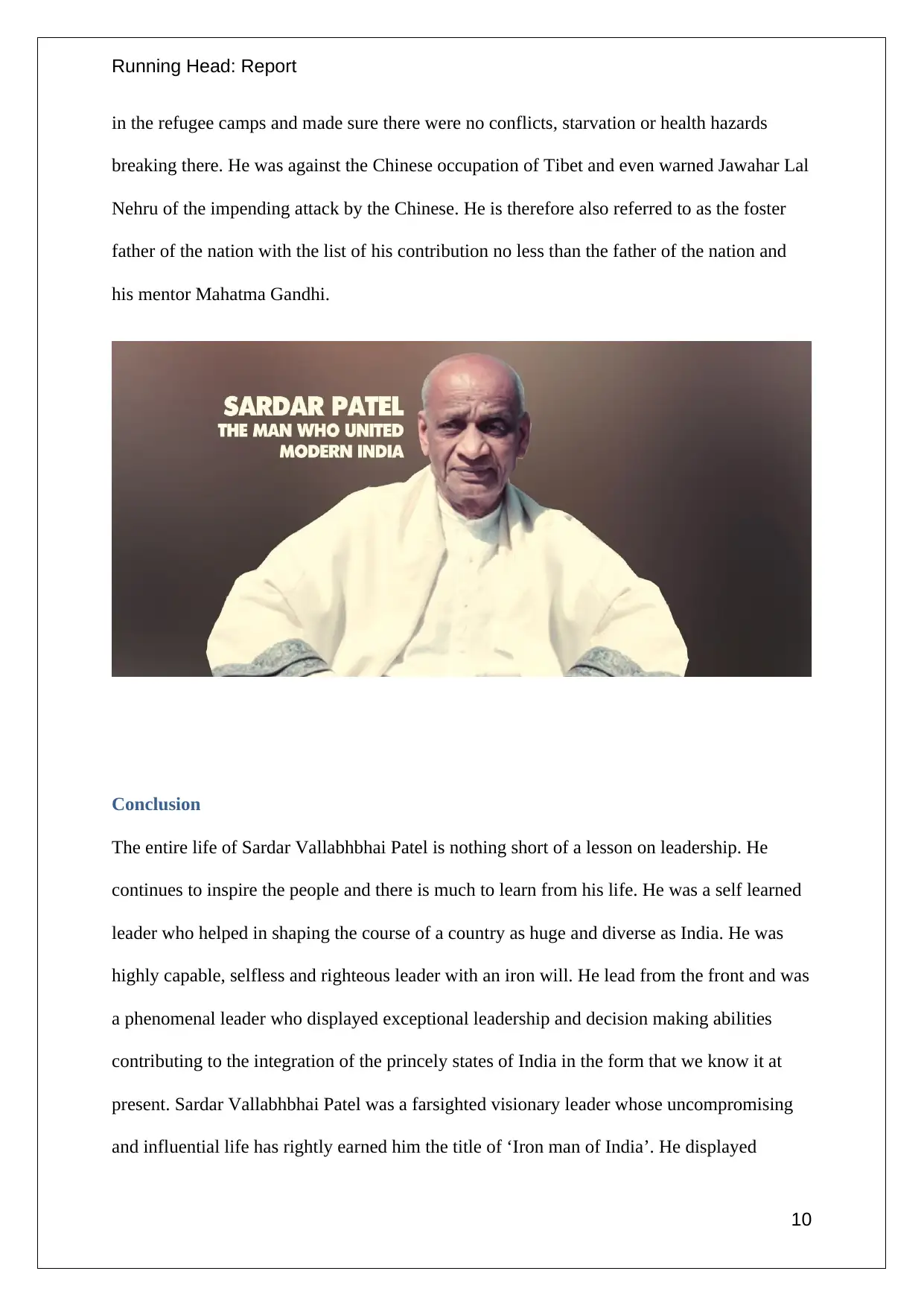
Running Head: Report
in the refugee camps and made sure there were no conflicts, starvation or health hazards
breaking there. He was against the Chinese occupation of Tibet and even warned Jawahar Lal
Nehru of the impending attack by the Chinese. He is therefore also referred to as the foster
father of the nation with the list of his contribution no less than the father of the nation and
his mentor Mahatma Gandhi.
Conclusion
The entire life of Sardar Vallabhbhai Patel is nothing short of a lesson on leadership. He
continues to inspire the people and there is much to learn from his life. He was a self learned
leader who helped in shaping the course of a country as huge and diverse as India. He was
highly capable, selfless and righteous leader with an iron will. He lead from the front and was
a phenomenal leader who displayed exceptional leadership and decision making abilities
contributing to the integration of the princely states of India in the form that we know it at
present. Sardar Vallabhbhai Patel was a farsighted visionary leader whose uncompromising
and influential life has rightly earned him the title of ‘Iron man of India’. He displayed
10
in the refugee camps and made sure there were no conflicts, starvation or health hazards
breaking there. He was against the Chinese occupation of Tibet and even warned Jawahar Lal
Nehru of the impending attack by the Chinese. He is therefore also referred to as the foster
father of the nation with the list of his contribution no less than the father of the nation and
his mentor Mahatma Gandhi.
Conclusion
The entire life of Sardar Vallabhbhai Patel is nothing short of a lesson on leadership. He
continues to inspire the people and there is much to learn from his life. He was a self learned
leader who helped in shaping the course of a country as huge and diverse as India. He was
highly capable, selfless and righteous leader with an iron will. He lead from the front and was
a phenomenal leader who displayed exceptional leadership and decision making abilities
contributing to the integration of the princely states of India in the form that we know it at
present. Sardar Vallabhbhai Patel was a farsighted visionary leader whose uncompromising
and influential life has rightly earned him the title of ‘Iron man of India’. He displayed
10

Running Head: Report
exceptional social and emotional intelligence and was empathetic to the people and
understood their needs. Sardar Vallabhbhai Patel was a nationalist leader always having the
best interest of his country in his mind. He also had a lot of respect for his culture and
religion.
11
exceptional social and emotional intelligence and was empathetic to the people and
understood their needs. Sardar Vallabhbhai Patel was a nationalist leader always having the
best interest of his country in his mind. He also had a lot of respect for his culture and
religion.
11
⊘ This is a preview!⊘
Do you want full access?
Subscribe today to unlock all pages.

Trusted by 1+ million students worldwide
1 out of 14
Related Documents
Your All-in-One AI-Powered Toolkit for Academic Success.
+13062052269
info@desklib.com
Available 24*7 on WhatsApp / Email
![[object Object]](/_next/static/media/star-bottom.7253800d.svg)
Unlock your academic potential
Copyright © 2020–2025 A2Z Services. All Rights Reserved. Developed and managed by ZUCOL.





